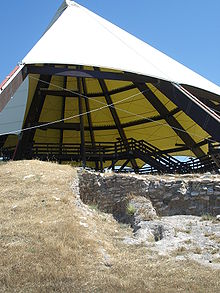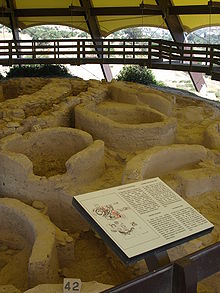Tenta
Coordinates: 34 ° 45 ′ 9 ″ N , 33 ° 18 ′ 11 ″ E
Kalavasos- Tenta is a settlement of the early akeramischen Neolithic in the Vasilikos valley in Cyprus .
location
Tenta is located in the Larnaka district , approx. 4 km south of Vouni near the south-east coast of the island.
excavation
Tenta was first excavated in 1974 by Porphyrios Dikeos , curator of the Cyprus Museum in Nicosia , and then examined more thoroughly from 1976 to 1984 under the direction of British archaeologist Ian Todd . The excavation is now under a PVC protective roof and can be visited.
Stratigraphy and dating
Todd distinguished four construction phases and one phase of initial settlement without a building (5), which he assigned to the second half of the 7th millennium. The earliest radiocarbon date, Kt-18 (9240 ± 130 BP ), came from the "Lower South Slope", which is not stratigraphically linked to the rest of the settlement. Mc Carthney divides the settlement into the following phases:
| phase | Levant | Construction phase Tenta | absolute date |
|---|---|---|---|
| Akrotiro phase | Late Natufien | - | 9,700 |
| Early Cypriot aceramic | ePPNB | 5 | 8,700-8,400 |
| medium cypriot aceramics | mPPNB | 4-2 | 8,300-7,500 |
| late Cypriot aceramics | lPPNB / PPNC | 1 | 7000-5,500 |
| Ceramic Neolithic | PN | - | from 5,500 |
buildings
Only post holes and pits are known from the first phase (5). In phases 4-2, the construction of round houses of quite different sizes consisted of adobe bricks. Phase 1 is poorly preserved, but the scant building remains can also be added to round houses. There are signs of an upper floor on some of the houses. The settlement was partially protected by a wall.
The place was repopulated in the early Chalcolithic , as shown by some pits in the lower slope area.
Finds
According to McCartney, the stone tools from phase 5 show certain similarities with the epipalaeolithic material from Aetokremnos . The preferred raw material is a translucent flint , which has been used primarily for unipolar microblades and small knives for discoid cores. In basic form production, tees and blades are almost equally common, with both unidirectional and bidirectional cores being used. However, real keel cores ( naviform cores ) are missing. There is almost no Anatolian obsidian , in contrast to the simultaneous settlements of Kissonerga-Mylouthkia and Parekklischa- Shilloroukambos . The devices have drills, notched blades and laterally retouched tees.
Pieces of jewelry made of picrolite , numerous stone vessels and two stone figurines were also found. Milling and grinding stones, mortars and axes were also made from rock.
Economy
It was einkorn , emmer and, in smaller amounts, barley grown, along with legumes such as lentils . Wild barley, figs , pistachios and vetch were collected.
Burials
14 burials were found, either in pits in the floor of the houses or next to the houses in layers of garbage. Only one lump of ocher was found as an additive . The skulls of the dead were partly artificially deformed .
literature
- Caroline McCarthy, The meaning of context for changing interpretations of the Cypriot aceramic Neolithic . In: D. Papaconstaninou (ed.), Deconstructing context. A critical approach to archaeological practice (Oxford, Oxbow 2006), 79-97.
- Ian Todd, Excavations at Kalavasos-Tenta , Vol. 1 (Jonsered, Paul Aströms Förlag 1987).
- Ian A. Todd, Excavations at Kalavasos-Tenta 2 (Göteborg: Paul Åströms, 2005), Studies in Mediterranean archeology 71/7.


